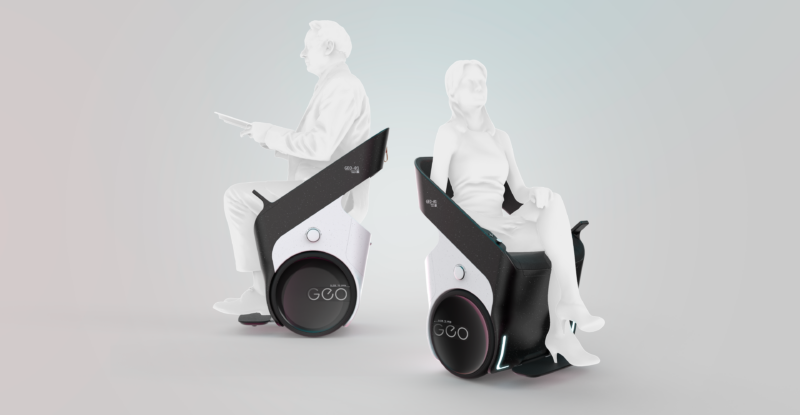 Persons with reduced mobility (PRMs) who need assistance navigating the airport are all too familiar with lacklustre passenger experiences on the ground. When a PRM must head directly to the gate because the wheelchair assistant is in demand, they can miss out on the anticipation and joy of socialising, dining, browsing retail, and being spontaneous.
Persons with reduced mobility (PRMs) who need assistance navigating the airport are all too familiar with lacklustre passenger experiences on the ground. When a PRM must head directly to the gate because the wheelchair assistant is in demand, they can miss out on the anticipation and joy of socialising, dining, browsing retail, and being spontaneous.
An innovation consortium comprising London-based design house PriestmanGoode (PG), electric vehicle maker Centaur Robotics, and location technology specialist Naurt, is aiming to bring back the thrill of air travel for PRMs, with its kerbside-to-gate mobility service called Geo.
Boasting integrated tracking and navigation technology, Geo enables level four autonomy where the vehicle performs all of the functions, but the user retains control. Moreover, an onboard personal assistant provides a virtual world at passengers’ fingertips.
In a one-on-one interview with PriestmanGoode associate director for strategy and customer experience Jo Rowan, RGN contributor Mary Doyle, who is a wheelchair user and an accessible aviation consultant, learns about Geo, and how the new product is seeking to normalise personal electric vehicles (PEVs) at airports, in what would be a clear win for some PRMs.
 RGN: How did the Geo come about, and how long did its development take?
RGN: How did the Geo come about, and how long did its development take?
Jo Rowan: It came about through a competition called Aviation X Lab challenge, and the main goal was to create something visionary to bring the joy back into the journey. PriestmanGoode; Centaur Robotics, developers of the revolutionary self-balancing Centaur; and Naurt, world leaders in location technology, created the Team Geo concept.
Discussions have taken two years. It’s quite easy to design something with a visionary approach knowing the social reasons for doing it. The development took a year, and the difficult bit is now!

A Geo presentation attended by His Highness Sheik Ahmed bin Saeed Al Maktoum, chair, chief executive of Emirates; and Sir Tim Clark, president of Emirates, which itself is a member of the Aviation X Lab incubator programme. Image: PriestmanGoode
RGN: What design input was received from the PRM community?
Joe Rowan: The foundation for the concept is the Centaur, which had extensive development and research already, and we have since run workshops and conducted interviews.
We have a lot of anecdotal evidence from our work in airport interiors, with PRMs and airlines, and the co-creation has already started and we will continue with focus groups to ensure we can now dig a little deeper.
With our experience on the other PG consortium Air4All (more news on that in the summer), we understand a variety of mobility solutions are required to support different PRMs.
These innovation projects are important to us at PG as we get to work on more things which are based on Universal Design and socially meaningful. We partner specifically with creators and suppliers who are SMEs (small and mid-size enterprises) to validate our products.
RGN: How is the Geo different than other PEV solutions?
JR: There are two key elements, the first one is the self-balancing, two-wheeled agility. With a very small footprint in a busy airport environment [and] not needing a large turning circle, it fits neatly under a table for dining.
And it’s about the person, not the chair, which was fundamental to the development. [It’s about] empowering the user and making them more visible rather than the chair itself.
We wanted something that met [the user’s] needs and felt desirable to use. Also, it’s about making the experience more ‘VIP’ so all people want to use it in many different environments.
RGN: Is it comfortable and easy to use?
RGN: The Centaur testing has been very favourable which has been the catalyst to create a product with a broader reach to be available to more people. It’s comfortable and the self-balancing is instant when people are lifting heavy items.
We have minimised the moving parts … and we looked to optimise the comfort for everybody, ensuring we have a solution which is durable and hard to break in the airport environment.
The navigation will ultimately be linked to a boarding pass and Geo will get you to the gate and when you need to start moving to arrive on time. Hopefully, the three-hour window of time [PRMs are asked to present themselves three hours before the flight] can be reduced or at least allow independence and spontaneity.
RGN: How long will it take to get the Geo into operation?
JR: We’re at the concept stage now, gauging interest with partners and moving in a great direction. The goal is that it could be in an airport environment in two years.

Team Geo also considered the infrastructure needed to support the service – such as charging docks, collection points, help points and the digital experience, which enables passengers to navigate the airport and ensure they are in the right place at the right time. Image: PriestmanGoode
RGN: What is the plan for this product and future PRM products from Team Geo?
JR: Once we get this into production, we hope to get this worldwide so it could be at both ends of the customer’s journey, maybe with a Geo luggage cart. We’re hoping to normalise these PEVs (Geo) and other devices.
We’re very excited about the opportunity to extend the Geo experience to include cruise ships, for example, where there is reduced space for multiple diners at a table who use conventional wheelchairs or scooters.
The Geo is slim and also takes up less cruise corridor space. It could be considered for campuses or any setting where there are long distances to cover; we are thinking very broadly.
This interview was uplifting as I know from the feedback I hear that this device will certainly give many PRMs an opportunity to maximise their airport enjoyment.
You can find Geo here.
Related Articles:
- Singapore expands automated gates with wheelchair and family lanes
- Ideas abound as US DOT eyes wheelchairs in the cabin
- NIAR students and Collins propose wheelchair-in-the-cabin solution
- Design enables wheelchairs in cabins without reducing seats
- BA autonomous wheelchair might change perception of PRMs
All images credited to PriestmanGoode














